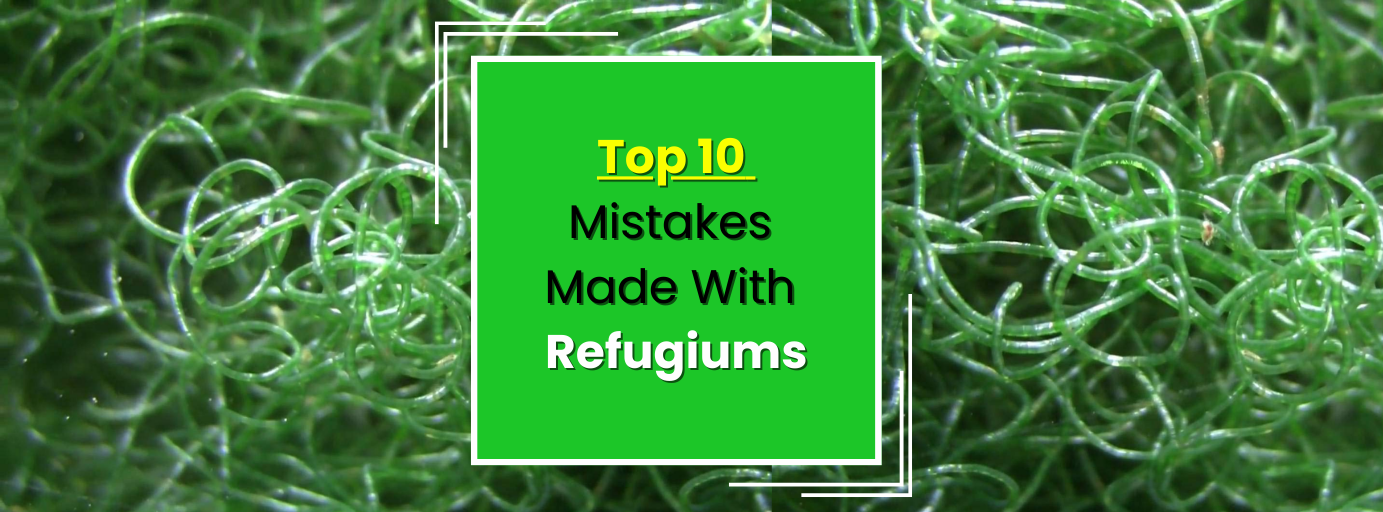
𝐈𝐧-𝐃𝐞𝐩𝐭𝐡 𝐋𝐨𝐨𝐤 𝐚𝐭 𝐭𝐡𝐞 𝐓𝐨𝐩 𝟏𝟎 𝐑𝐞𝐟𝐮𝐠𝐢𝐮𝐦 𝐌𝐢𝐬𝐭𝐚𝐤𝐞𝐬
Refugiums are invaluable to the health of your saltwater aquarium, but there’s a learning curve. Let’s dive deep into each common mistake, so you can set yourself up for success and avoid the pitfalls. These are the top 10 mistakes that I see the most often.
1. Not Enough Flow
- Why It Happens: Hobbyists often assume refugiums require low flow for nutrient absorption, but too little flow creates stagnant zones.
- The Consequences:
- Detritus accumulates, providing a nutrient source for nuisance algae.
- Macroalgae like Chaetomorpha may collect dirt, reducing its efficiency.
- Anaerobic zones can develop unintentionally, leading to hydrogen sulfide pockets.
- How to Fix It:
- Use pumps or powerheads to maintain a gentle, consistent flow.
- Aim for a turnover rate of 4–6 times the refugium’s volume per hour.
- Observe your macroalgae—it should sway slightly, not lie limp.
2. Ignoring the Lighting Spectrum
- Why It Happens: Using old or inappropriate lights designed for fish or corals instead of macroalgae can stunt growth.
- The Consequences:
- Insufficient photosynthesis slows nutrient uptake.
- Light outside the 5,000K–6,500K range can encourage nuisance algae.
- How to Fix It:
- Invest in refugium-specific lighting like the Kessil H80 or AI Prime Fuge.
- Overtime the light spectrum shifts as lights age.Replace older light bulds (if not using LED) every 9–12 months to avoid spectrum shifts.
- Run the refugium lights on a reverse photoperiod (opposite your display tank) to stabilize pH swings.
3. Overcrowding with Macroalgae
- Why It Happens: The belief that more algae equals better nutrient export often leads to overcrowding.
- The Consequences:
- Algae block water flow, creating detritus traps.
- Overgrowth can cause macroalgae to die back, releasing nutrients back into the water.
- How to Fix It:
- Harvest macroalgae every 1–2 weeks.
- Remove about 20–30% of the algae at a time to prevent nutrient spikes.
- Avoid packing the refugium too tightly—light and flow should reach all areas.
4. Adding the Wrong Macroalgae
- Why It Happens: Some macroalgae are selected based on availability rather than suitability.
- The Consequences:
- Species like Caulerpa can “go sexual,” releasing spores and nutrients, causing cloudy water and nutrient spikes.
- Less hardy algae may decay quickly in poor conditions.
- How to Fix It:
- Stick to beginner-friendly species like Chaetomorpha, which doesn’t root or go sexual.
- If using Caulerpa, trim it regularly and provide strong lighting to reduce the risk of sporing.
- Gracilaria is another good option, especially if you have herbivorous fish like tangs.
5. Skipping Maintenance
- Why It Happens: Refugiums are often treated as “set it and forget it” systems.
- The Consequences:
- Detritus buildup reduces water quality.
- How to Fix It:
- Siphon detritus during water changes to prevent nutrient buildup.
- Inspect the refugium weekly for pests or overgrowth.
- Regularly clean powerheads and return pumps to ensure optimal flow.
6. Overlooking Biodiversity
- Why It Happens: Hobbyists often focus solely on macroalgae, neglecting the microfauna that help maintain balance.
- The Consequences:
- Reduced natural food sources for corals and fish.
- Less competition for nutrients, which may favor nuisance algae.
- How to Fix It:
- Seed the refugium with copepods, amphipods, and live sand.
- Add a small piece of live rock to encourage microfauna growth.
- Consider purchasing pod booster kits for periodic replenishment.
Tamara's Pro Tip: Once your refugium is established and you start seeing massive amounts of copepods and amphipods I like to put the extra pods in my main tank. When harvesting algae, I shake it in my main tank to get the pods to transfer allowing them to settle, or quickly get eaten, depending on the tank inhabitants.
7. Using a Bare-Bottom When a Sand Bed Is Needed
- Why It Happens: Bare-bottom refugiums are easier to clean, but they lack the denitrifying benefits of sand beds.
- The Consequences:
- Limited habitat for beneficial anaerobic bacteria.
- Reduced biodiversity and fewer natural processes for nutrient breakdown.
- How to Fix It:
- If nutrient reduction is a goal, add a 4–6 inch sand bed.
- For anaerobic denitrification, consider a deep sand bed (6+ inches) with fine-grain sand.
- Mix sand periodically with live sand to maintain microbial diversity.
8. Failing to Test Water Parameters
- Why It Happens: Refugiums often show immediate benefits, leading hobbyists to stop monitoring their effectiveness.
- The Consequences:
- Nutrient levels can creep up unnoticed, leading to algae issues in the display tank.
- Over-harvesting algae can deplete nutrients too quickly, stressing corals.
- How to Fix It:
- Test for nitrates, phosphates, and pH weekly.
- Adjust feeding, flow, or macroalgae harvesting based on test results.
- Log test results to identify trends and refine your refugium’s role in nutrient management.
9. Inadequate Size
- Why It Happens: Space constraints lead to refugiums that are too small to impact nutrient export significantly.
- The Consequences:
- Insufficient nutrient export for heavily stocked or high-nutrient tanks.
- Limited space for biodiversity or algae growth.
- How to Fix It:
- Aim for a refugium that’s 10–20% of your display tank’s water volume.
- If space is an issue, use a Chaeto reactor or standalone refugium.
- Supplement a small refugium with other filtration methods like GFO or carbon dosing.
10. Pests and Hitchhikers
- Why It Happens: Live rock or sand introduced without proper quarantine can bring unwanted critters into the refugium.
- The Consequences:
- Pests like aiptasia or flatworms can overrun the refugium and spread to the main tank.
- Invasive bristle worms or crabs can damage beneficial organisms or macroalgae.
- How to Fix It:
- Quarantine live rock and sand before adding them to your refugium.
- Manually remove pests during weekly inspections.
- Use natural predators, like peppermint shrimp for aiptasia or wrasses for flatworms, if appropriate.
